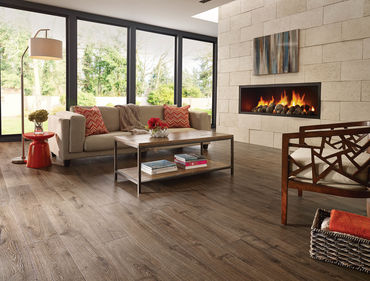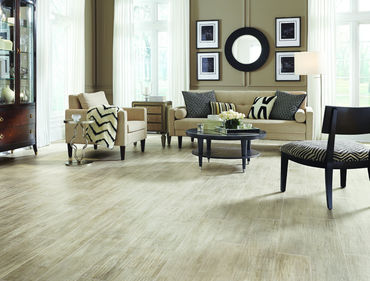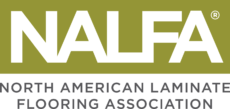Product Info
Why Laminate Flooring Works
Laminate has garnered nationwide acceptance from the dealer’s showroom to the homeowner’s floor. To understand this phenomenon, consider all aspects of this dynamic and continuously developing product category:
Manufacturing
Laminate flooring products are manufactured using the latest technologies available. These products are produced using manufacturing tolerances that were unheard of until now and this leads to greater customer satisfaction for “out of the box” fit and finish of the products. The consumer, who has tried one Laminate floor, will definitely consider another.
Installation
The ease of installation using today’s state of the art locking systems makes installation of laminate flooring truly the consumer’s choice. The average consumer would be very successful installing his or her own flooring. But even if they choose to have their flooring professionally installed, they will find that installation costs are still very attractive when compared to the cost of installing other floor covering systems. The “floating” system also provides Laminate flooring with almost unlimited application areas throughout the home or office environments, while allowing same day installation and use.
Core Materials
Today’s superior High Density Fiberboard core characteristics include great dimensional stability, excellent impact resistance, and moisture resistance, making Laminate flooring a perfect fit for today’s demanding household conditions.
Surfaces and Designs
With the ability of Laminate flooring to ‘imitate’ virtually any floor covering, both in look and in texture; the consumer now has the option to install nearly identical appearances to traditional stones, hardwoods, and ceramic tiles, while cutting the maintenance costs of those types of floor coverings by up to half. Advances in digital imaging and printing technologies are bringing the ‘look’ of laminate flooring so close to the original look of woods, stones or ceramics as to be barely discernible. Laminate Flooring is now an acceptable floor-covering alternative in almost every room in the home.
Wear Layers
The typical Laminate flooring wear layer of today is the driving force of this industry. The ability to clearly show the chosen design beneath, while providing the ultimate in wear protection, is no longer considered a novelty, it is the most basic product expectation.
Coordinating Trims and Transitions
In the past, a major concern for Laminate flooring and floating installation systems was that they do require some special provisions for expansion zones between certain rooms and around ‘island’ cabinetry. With today’s new coordinating trim pieces and specialized mounting systems, Laminate flooring manufacturers are making those ‘concerns’ disappear, and replacing them with stylish, almost invisible trims for floor and wall areas.
Warranties
Laminate flooring offers consumers some of the best warranty coverage available throughout the floor covering industry, and does so at attractive price points. Consumers now expect better performance from Laminate flooring than they do from other traditional floor coverings costing the same.
Care and Maintenance
Today’s Laminate flooring wear layers make caring for the flooring a breeze. If using good quality walk-off mats at entryways; most consumers will require just weekly dry maintenance of the flooring using a standard cotton dust mop. Even shoe scuffmarks can be removed from the Laminate flooring surface using this method. [Sticky spills should be spot cleaned with a damp cloth and then dried. The entire floor does not need to be “washed” to get those 1 or 2 spills. It is recommended that the head of the cotton dust mop be taken off periodically; tossed in the washer for a thorough cleaning; dried thoroughly in the dryer; and continued to be used for years of easy maintenance.]
NALFA
The North American Laminate Flooring Association continues to push this dynamic product category in the right direction through the Standards writing process and through manufacturer participation in the Product Certification Program. NALFA also counts among their membership many of the manufacturing supply and support companies around the nation. This group of serious manufacturers and concerned supply and support companies continues to review and revise the NALFA Standard on an ongoing basis. This very active group keeps the entire industry moving in the right direction, because all manufacturers know that whether they have had their products certified or not; their products will be compared to those products that have met NALFA standards.
In short, the ‘near perfect’ manufacturing processes, easy installation, superior materials, state of the art designs and textures, extraordinary wear capabilities, total package trims and accessory systems, strong warranty coverage, easy care and maintenance, and the continued support of a very involved standards organization called NALFA will keep Laminate flooring “working” for years to come.
NALFA
The primary purpose of the North American Laminate Flooring Association is to create voluntary product performance standards for laminate flooring in North America. While NALFA acknowledges the advantages and benefits of laminate flooring underlayments, it is the position of the association that the obligation of creating minimum performance standards and requirements for laminate flooring underlayment products must be left to the discretion of individual laminate flooring and underlayment manufacturers. It is, however, within the domain of NALFA responsibilities to establish guidelines for the evaluation of laminate flooring underlayment. The following white paper link is designed to provide laminate flooring and underlayment manufacturers, distributors, dealers and customers with the appropriate information and the specific testing methods needed to evaluate and compare laminate flooring underlayments. Laminate flooring underlayment products encompass a wide variety of materials and characteristics. It is the purpose of this report to define specific properties common among underlayment products and assign specific standard industry testing methods for the evaluation of those properties. Download Underlayment Evaluation White Paper
Mold and Mildew
Issues concerning mold and mildew are gaining increased attention from both residential and commercial property owners as well as the public at large. In virtually all situations if there is a mold issue, there is an excessive moisture issue. In order to prevent, control, or remediate mold and mildew, one must first identify, evaluate, and eliminate the source of excessive moisture. Prior to removing an existing flooring or installing a new floor or repairing an existing laminate floor, if there are visible indications of mold or mildew or the presence of a strong musty odor in the area where flooring is to be removed or installed, the source of the problem should be identified and corrected. To deal with mold and mildew issues, you should refer to the U.S. Environmental Protection Agency (EPA) guidelines that address mold and mildew. Depending on the mold and mildew condition present, those remediation options range from clean-up measures using gloves and biocide to hiring a professional mold and mildew remediation contractor to address the condition. Laminate flooring, because it is relatively non-porous, allow any mold and mildew on the flooring surface to be easily cleaned. Remediation measures may require structural repairs such as replacing underlayment and/or subfloor contaminated with mold or mildew as a result of prolonged exposure to moisture. The EPA mold guidelines are contained in two publications “A Brief Guide to Mold, Moisture and Your Home” (EPA 402-K-02-003) and “Mold Remediation in Schools and Commercial Buildings ” (EPA 402-K-01-001). Appendix B of the “Mold Remediation in Schools and Commercial Buildings” publication describes potential health effects form exposure to mold, such as allergic and asthma reactions and irritation to eyes, skin, nose and throat. These publications can be located on EPA’s website at www.epa.gov/iaq/molds/.


